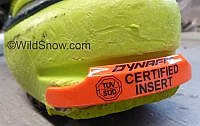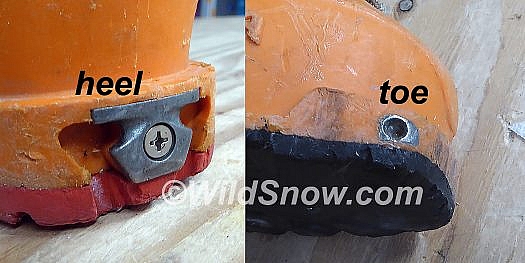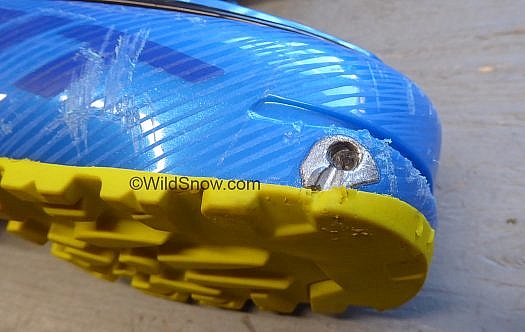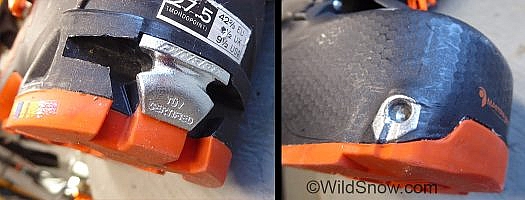This post sponsored by our publishing partner Dynafit.

In the case of the three “Dynafit” type tech fittings we outline below, we favor the Dynafit certified versions rather than those made by various second parties. With new boots, certified fittings are indicated by a red plastic clip-seal on the toe of the boot, as pictured above. Note the TUV badge as well, see note at end of this post. Click images to enlarge.
If you don’t chop your salad too fine, you can pick out those tasty chunks of artichoke. Likewise, we are in a good, but not exceptional place these days with ski boot “tech” fittings. Those little steel lugs at the toe and heel, designed to attach various binding options. We presently have five or six items in the salad (including La Sportiva variations). The four “Dynafit” types are detailed here, see this post for La Sportiva.
Following, official names with the shorthand we use while blogging (and making salad orders at our local ski shop).

Dynafit Standard tech insert on the heel and toe, notice the thickness of the sole material under the toe fitting. This is the only type fitting that provides a smooth outer profile to the sole, which is best for bindings such as Salomon Shift. The Dynafit Quick Step is certified to function with Shift as well. In either case, with Shift, bench evaluation of release is mandatory. Some boot makers produce their own fittings. While those can work, we prefer the Dynafit branded fittings, which have thus far been indicated by a red plastic clip as shown in our lead photo above.
Dynafit Standard Insert (Standard): The original Dynafit retail version, simple, effective. More room for boot sole material at toe, slightly more difficult to enter binding than other versions of toe fittings. Heel unit is attached with small hidden pins and one small screw. Overall, this is our favorite insert (though our fantasy inserts use this toe along with Master Step heel). We wave our scarves in honor of inventor Fritz Barthel, who came up with this thing more than thirty years ago because he was “lazy,” and made something that is still the best. Why is this type of fitting so nutritious? The toe has no extra material. It is minimalist. Thus, your boot sole has room to wear. Downside is the heel unit attachment, which is somewhat weak.

Dynafit Quick Step In (QSI) toe insert fitting. Uses the same heel insert as Standard fitting pictured above. At first glance, can be confused with Master Step below, note that Master Step heel fitting is obviously different, the toe is a different shape.
Dynafit Quick Step In (QSI) (Quick Step): Standard lead-in notch at toe that can help with binding entry. Yet the heel unit is identical to the Standard type fitting. We’ve seen problems with this type of heel fitting’s durability. The Master Step heel is much better. So you have a Faustian bargain. If you want the stronger heel, you’re stuck with either the Quick Step or Master Step toe. You can probably live with it. Life is so harsh…

Dynafit Master Step is easiest to ID by the heel fitting (left). It is attached from the inside, stronger than Standard and Quick Step versions. Pictured here on toe of Dynafit Hoji Pro model boot
Dynafit Master Step (Master Step): (Enhanced lead-in at toe, vastly improved heel that’s fastened from inside the boot.)
Note that La Sportiva makes their own inserts, compatible with both the Trab TR2 and most “Dynafit” type bindings. Sportiva now offers a confusing variety of their inserts. We’ll detail those in a separate post.
Mystery inserts (who do you trust?): Various boot companies make their own Dynafit type inserts, with mixed success. We’ve had more than one bad experience with this, like finding a bug in your salad: inserts that wear quickly, inserts that don’t safety release correctly from the binding. As there is no official industry standard for inserts, this is a major “buyer beware.” That’s not to say you should avoid buying boots with insert copies, only you should be extra careful. Watch social media for consumer “testing” gone awry, and be sure to test boot/binding combinations for proper safety release. To be fair, over the years we’ve seen a few problems with official Dynafit inserts as well (though not as often). Again, trust by verify.
(Note: TUV is a for-profit company that tests products for conformance to norms and standards. Such standards can be any of numerous flavors. Standards can be legally mandated by government, or agreed within the industry and formalized through the ISO organization, OR simply provided by a company as an “internal” standard. For example, if I wanted to write a standard for how many periods I used in a blog post, I could pay TUV to test my blog posts and certify them. The Dynafit fittings seal is a good example of an “internal” standard. There is no legally mandated standard for tech fittings, nor is there an ISO norm-standard. Instead, if the TUV badge is on the boot seal, one would assume Dynafit simply supplied their own voluntary-internal standard to TUV, which TUV then tested for. All that said, the entire system of norms and standards, TUV, ISO and DIN is a confusing jungle. As a consumer, your job ONE is to either know how to test binding-boot combinations yourself, or else work with a competent retailer who can do it for you.)
(Important note! As the Master Step toe fitting may not be as compatible with DIN alpine binding toes a the Quick Step In or Standard toe fittings, you’ll see boots mixing the salad parts. For example, the Hoji Free boot for fall 2019 will have a Master Step heel and Quick Step In toe.)
WildSnow.com publisher emeritus and founder Lou (Louis Dawson) has a 50+ years career in climbing, backcountry skiing and ski mountaineering. He was the first person in history to ski down all 54 Colorado 14,000-foot peaks, has authored numerous books about about backcountry skiing, and has skied from the summit of Denali in Alaska, North America’s highest mountain.
